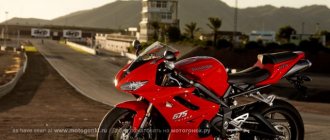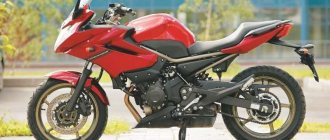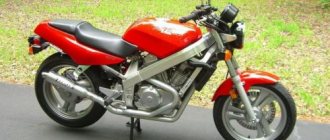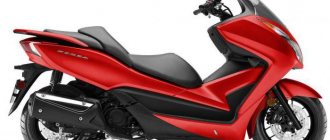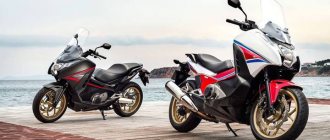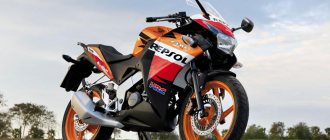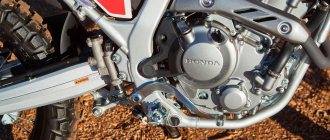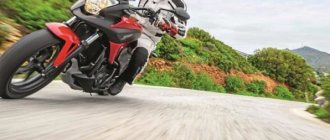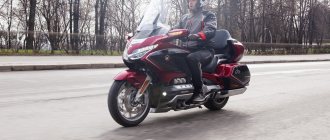The new product from Honda - model DN-01 - has become one of the most discussed among motorcyclists and all those who care about powerful two-wheeled vehicles. This motorcycle comfortably coexists with a stylish original design, a powerful engine, an automatic gearbox, an ABS system and other useful functions. Thanks to these qualities, Honda dn-01 motorcycles can be called unique equipment that will not only impress others, but also make travel as comfortable as possible.
For whom
Here are the main advantages of the Honda DN-01:
- excellent balancing, smooth running;
- comfortable, but extremely low rise;
- sustainability;
- ease of operation;
- Quite impressive performance.
The model may be of interest primarily to those bikers who like futuristic technology. Of course, the company made a mistake when it positioned the motorcycle as a touring machine. If they had called their bike a motorcycle for the city, perhaps his career would have turned out differently.
Unusual, but convenient
THIS morning I set off, sitting comfortably in the deep saddle of a large motorcycle and feeling... unusual, to put it mildly. No traditional clutch lever under the left hand, no traditional gear shift under the left foot. In their usual places, only the brake lever (on the right side of the handlebar) and the brake pedal at the right footrest. The huge steering wheel seems to fall into your hands. Somewhere ahead, unnaturally far away, there was an abstract headlight glowing with bluish xenon. This steering wheel removes any doubt about the class of the motorcycle. Chopper, of course.
Before setting off, I meditate a little, carefully pushing into the back of my mind all my past experience of driving a motorcycle, all the stereotypes and skills that have been brought to automaticity over many years. Well, imagine that you’ve driven a manual car all your life and suddenly switched to a version with an automatic transmission. It’s just right to tie your left leg to the seat so that you don’t have the urge to depress the non-existent clutch pedal. And my hand is always mechanically looking for the manual transmission lever...
Yes, I don’t have much left of driving a bike in the classical sense. You'll have to relearn as you go. However, this should not be difficult - after all, the concept of an automatic transmission itself is aimed precisely at making it easier and as simple as possible to control a motorcycle. It is not for nothing that it is called here HFT - “Human Friendly Transmission”, which literally means “human-friendly transmission”. Let's check how true this is...
I turn the key, and the V-twin engine (four-stroke, two cylinders, eight valves, 680 cc, liquid cooling) growled pleasantly somewhere below, under the 15-liter gas tank. By the way, the shape of the tank is very bizarre, but, as it turned out a little later, very convenient. Extremely wide at the top, this tank becomes very narrow in the area of the rider’s knees. It’s very convenient – you don’t get tired at all on long “shots” along the highway. Tested for myself.
All my further manipulations to control the bike will be reflected on the display. Using the button on the right handle of the steering wheel, I switch to position “D” - “drive”. For safety reasons, this should be done every time you start the engine. On the left handle, I can choose two modes at my discretion: regular “D” or sports “S”. To begin with, I limit myself to the usual, and the Honda DN-01 sets off with the smoothness of a transatlantic ferry leaving the pier. I'm waiting - now there will be slight shocks when switching, which are characteristic even of expensive cars with an ultra-modern eight-speed automatic transmission... But the Honda DN-01 does not even have a hint of such sensations. The only thing is that at traffic lights or at a complete stop, when the gear “falls out” into neutral, you feel that the revolutions have dropped, that’s all, perhaps.
I almost forgot to tell you about the two large keys on the left side of the steering wheel. With their help, you can switch the automatic transmission to manual shift mode. Why did I almost forget? Because I tried it, switched it around and came to the conclusion: the “automatic” itself does it much better. I turned on the “S” position and forgot about manual mode until the evening. And in fact, this box is not an enemy, but a kind assistant to the biker.
Dimensions and weight
This is a fairly long bike – 2343 mm. The model reaches 837 mm in width and 1120 mm in height. The wheelbase here is 1609 mm, and the height of the bike at the saddle is 713 mm. Together with fuel, the car weighs 270 kg, and the volume of its gas tank is 15.3 liters. Taking into account the average gasoline consumption of 5 liters per hundred kilometers, this is quite enough.
Characteristics of model dn-01
You should consider in detail the technical characteristics of this model from a well-known Japanese manufacturer:
| Dimensions (length; width; height) | 231.5; 82; 111.5 cm |
| Weight | 270 kg |
| Maximum speed | 170 km/h |
| Fuel tank volume | 15.1 l. |
| Engine | 4-stroke 2-cylinder liquid cooled |
| Fuel consumption per 100 kilometers | 4 l. |
| Engine capacity | 680 cc cm |
| Start | Electric starter |
| Engine power | 61 l. With. at 7500 rpm |
| Brake system | Disc hydraulic |
| Suspensions (front; rear) | Telescopic fork; cantilever with monoshock absorber |
The impressive power of the engine with automatic transmission, as well as low fuel consumption during the combined cycle, attracts many motorcyclists. Despite its significant weight of 270 kg, the motorcycle is very easy and comfortable to drive on roads with any surface. A reliable and soft suspension on a motorcycle allows you to minimize discomfort when riding over bumps and potholes. An excellent braking system that prevents wheel locking allows the driver to feel confident on ascents and descents, as well as during emergency braking.
Chassis and brakes
DN-01 has a frame made of steel. This is a duplex type. It looks very modern even now. There is a lot of futurism in the appearance, especially with regard to the front shape of the motorcycle. The wheel rims and steering wheel look minimalistic, but at the same time, quite bright.
The rear suspension is a pendulum version with a shock absorber. At the front, a telescopic fork measuring 41 mm was used. The rear brake is a 276 mm disc with a two-piston caliper, while at the front there is a pair of 296 mm discs with three-piston calipers.
Advantages and disadvantages of the model
The Honda dn-01 motorcycle has plenty of advantages, so we will list only the main ones:
- Interesting and stylish design, combining chrome parts and glossy plastic lining.
- Maximum ease of use, achieved by the presence of an automatic transmission, thanks to which riding this motorcycle can be compared to riding a scooter.
- High-quality ABS, providing complete braking control on any type of road surface.
- Convenient and intuitive motorcycle electronics, which includes the proprietary HISS ignition safety system.
- The low seat height (69 cm) will appeal to people of short stature, making driving a motorcycle comfortable for them.
The disadvantages of the model include the following:
- The engine for such a unit could be more powerful.
- The front fairing does not provide adequate wind protection.
- The luggage compartment of the motorcycle is small in size, so for long trips you will have to think about a system of additional panniers.
- The small suspension travel cannot provide adequate comfort when driving over rough terrain.
In general, this Honda motorcycle model can be called successful, as it meets many of the requirements of motorcyclists.
Description
The D15B is an improved modification of the D15 powerplant from Honda. Initially, the engine was designed for use in the Honda Civic, but later it became widespread and began to be installed on other models. It consists of an aluminum cylinder block with cast iron liners. The head contains one camshaft, as well as 8 or 16 valves. The timing belt is driven by a belt, and it is recommended to change the belt itself every 100 thousand kilometers. If it breaks, the valves in the engine cylinder head will definitely bend, so you need to monitor the condition of the belt. There are no hydraulic compensators, so the valves need to be adjusted after 40,000 kilometers.
The special feature is counterclockwise rotation. In one engine, the fuel mixture is supplied through two carburetors (developed by Honda), using a mono-injection system (when atomized fuel is supplied to the intake manifold) and an injector. All these options are found in one engine of different modifications.
Motorcycle debut
At the Tokyo Auto Show in 2005, the Honda DN-01 was first demonstrated, which was immediately called an interesting type of concept bike with the sad fate of being forgotten immediately after its appearance. The supposed continuously variable transmission was supposed to guarantee excellent performance, which seemed like an unrealistic promise that was standard on all concepts.
However, the sad assumptions did not come true: many years of development and research were embodied in a model that inherited and combined all the technical and styling characteristics presented in the concept - the Honda DN-01.
Innovative transmission
Honda engineers managed to achieve similar results thanks to the development of a new transmission. The automatic transmission has been designed to provide continuously variable power conversion, immediate response to changing road conditions, confident response, optimized power flow to the drive wheel and perfect steering control.
The innovative transmission was first installed on the Honda DN-01 in 2005 and was called the Friendly Transmission, or HFT. The design combines the ease of control of a scooter with the precise performance of a classic motorcycle drivetrain. HFT provides a smooth and easy ride coupled with excellent and dynamic acceleration, making the DN-01 a sports concept that marks the beginning of a new generation of motorcycles.
Malfunctions
For all their advantages, D15B units have problems. The most common are the following “diseases”:
- Floating speed indicates a malfunction of the idle speed control sensor or carbon deposits on the throttle valve.
- Broken crankshaft pulley. In this case, you have to replace the pulley; rarely, you need to replace the crankshaft itself.
- A diesel sound coming from under the hood may indicate a crack in the housing or a leak in the gasket.
- Distributors are a typical “disease” of D-series engines. When they “die,” the engine may twitch or refuse to start at all.
- A little detail: lambda probes are not durable and, with low quality fuel and lubricant (which is common in Russia), quickly become unusable. The oil pressure sensor may also leak, the injector may become clogged, etc.
All these problems do not negate the reliability and ease of repair and maintenance of internal combustion engines. If you follow the maintenance recommendations, the engine will easily travel 200-250 thousand kilometers without problems, then depending on your luck.
Tuning
D series motors, in particular the D15B modification, are practically unsuitable for serious tuning. Changing the cylinder-piston group, shafts, installing a turbine - all these are useless exercises due to the small safety margin of D series engines (except for engines produced after 2001).
However, “light” tuning is available, and its possibilities are wide. With little money, you can turn an ordinary car into a fast car that will easily outperform modern multi-compact cars at the start. To do this, you need to install this installation on an engine without VTEC. This will increase power from 100 to 130 hp. With. Additionally, you will have to install the intake manifold and firmware to teach the engine to work with the new equipment. Experienced craftsmen will be able to upgrade the motor in 5-6 hours. From a legal point of view, the engine does not change at all - the number remains the same, but its power increases by 30%. This is a solid increase in strength.
What should VTEC engine owners do? For such internal combustion engines, a special turbo kit can be made, but this is a complex procedure and is rarely used. However, the engine resource is conducive to this.
The tips for improving internal combustion engines described above apply to units manufactured before 2001. Civic EU-ES engines, due to their design features, are less suitable for modernization.
Service
Since the B series engines turned out to be simple, there are no subtleties or difficulties in maintenance. Even if the owner forgets to change any filter, antifreeze or oil on time, nothing catastrophic will happen. Some mechanics at service stations claim that they have observed situations where D15B engines drove 15 thousand kilometers on one lubricant, and when replaced, only 200-300 grams of used oil were drained from the pan. Many owners of old cars based on this engine filled it with regular tap water instead of antifreeze. There are even rumors of D15Bs running on diesel when owners mistakenly filled them with the wrong fuel. This may not be true, but such rumors exist.
Such legends about the popular Japanese engine allow us to clearly conclude about its reliability. And although it cannot be called a “millionaire”, with proper maintenance and careful care, it may be possible to reach the cherished mileage of a million kilometers. The practice of many car owners shows that 350-500 thousand kilometers is the resource before major repairs. The thoughtfulness of the design allows you to revive the engine and drive another 300 thousand kilometers.
However, this does not mean that absolutely all D15B motors have such a huge resource. Moreover, not the entire series is successful, but only engines up to 2001 (that is, D13, D15 and D16). D17 units and its modifications turned out to be less reliable and more demanding in terms of maintenance, fuel, and lubrication. If the D series engine was produced after 2001, then it is advisable to monitor it and carry out routine maintenance on time. In general, all engines need to be serviced on time, but the D15B will forgive the owner for his absent-mindedness, most other engines will not.
